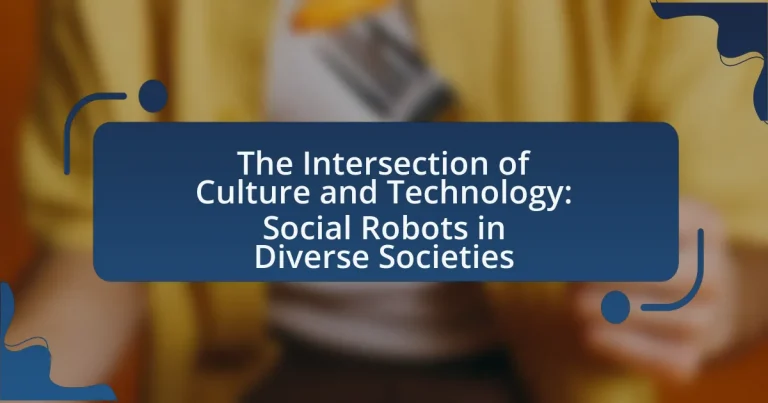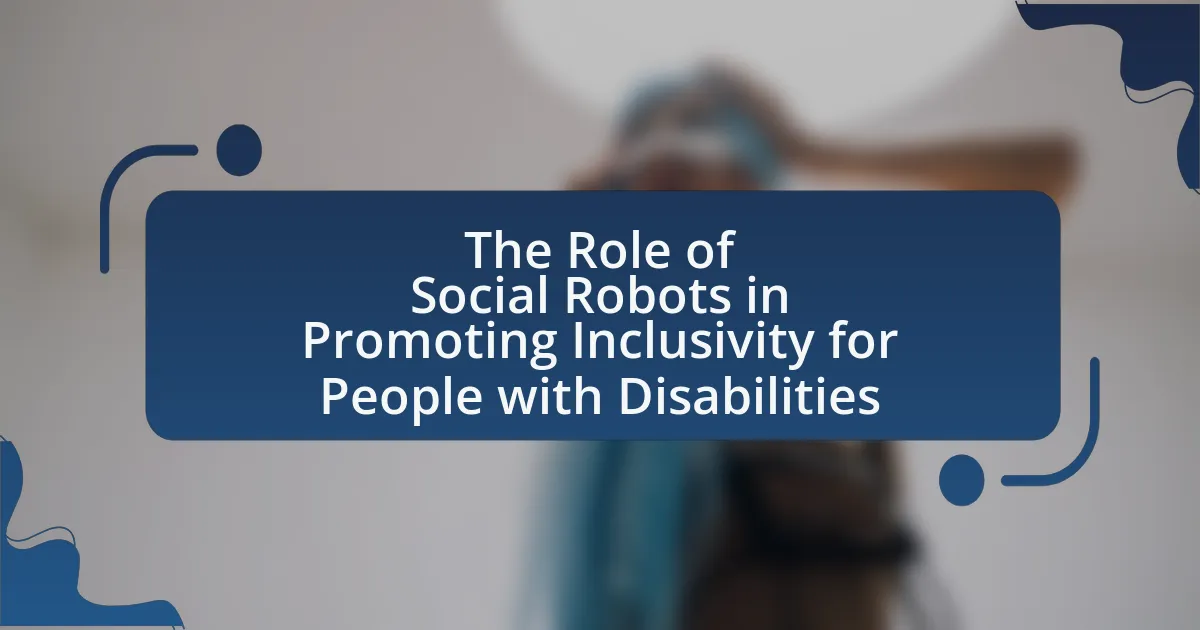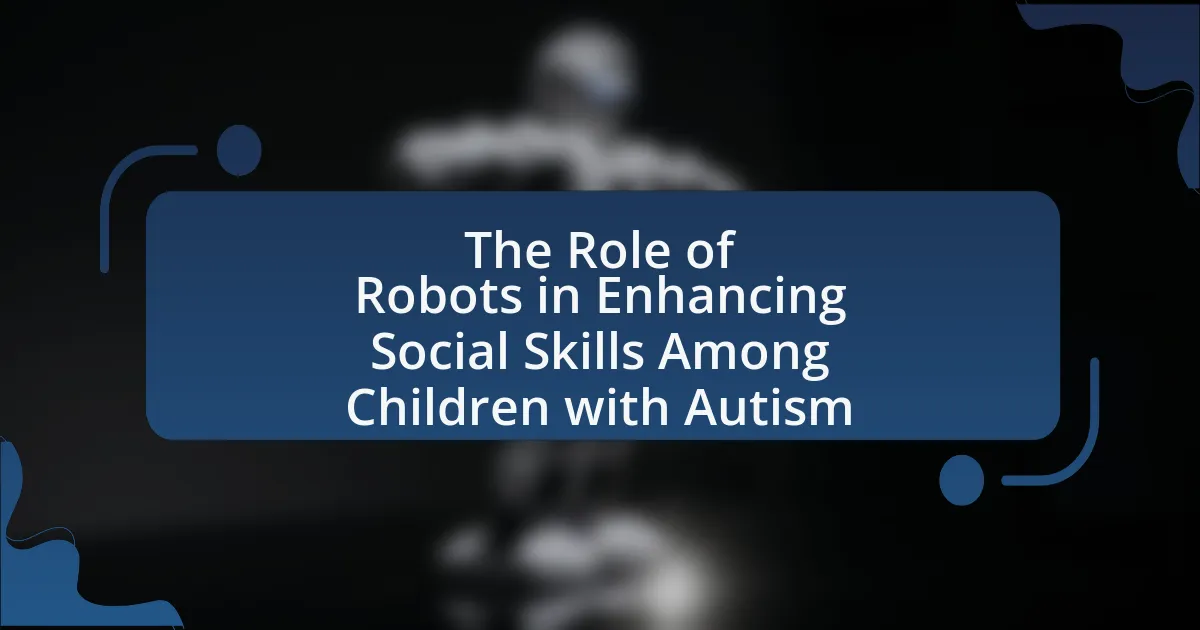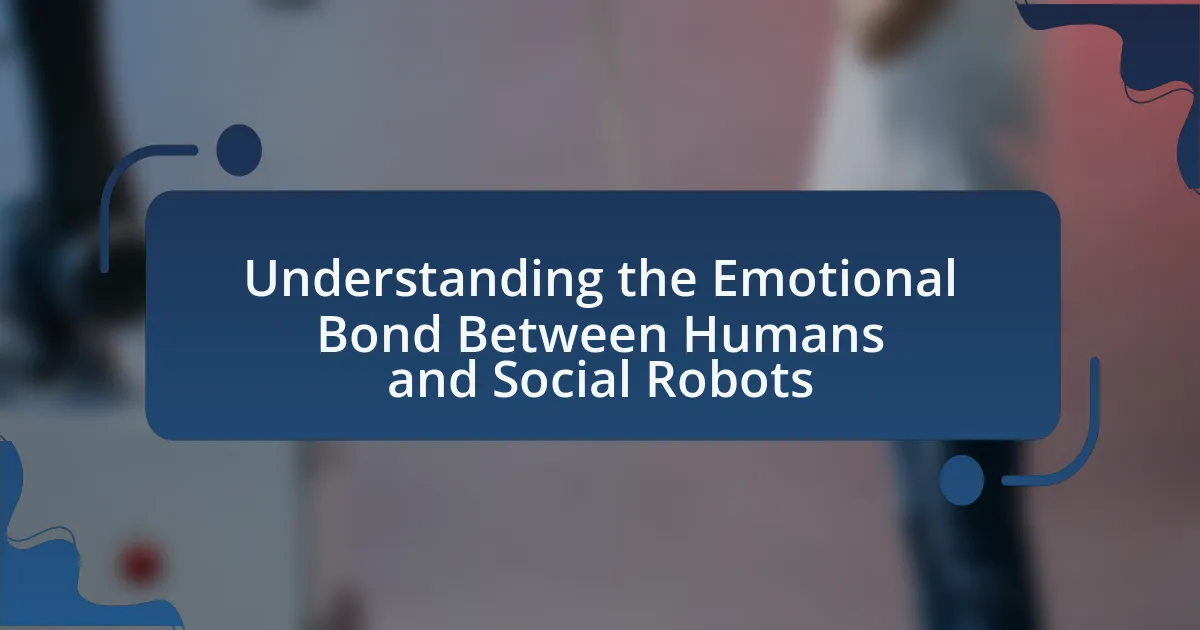The article examines the intersection of culture and technology in the realm of social robots, highlighting how cultural norms and values shape their design and functionality. It discusses the ways social robots reflect cultural values in diverse societies, the role of cultural context in their design, and how they adapt to different cultural practices. Additionally, the article explores the implications of social robots on cultural dynamics, their categorization across cultures, and the ethical considerations surrounding their use. It emphasizes the importance of cultural sensitivity in the development of social robots to enhance cross-cultural communication and community engagement.
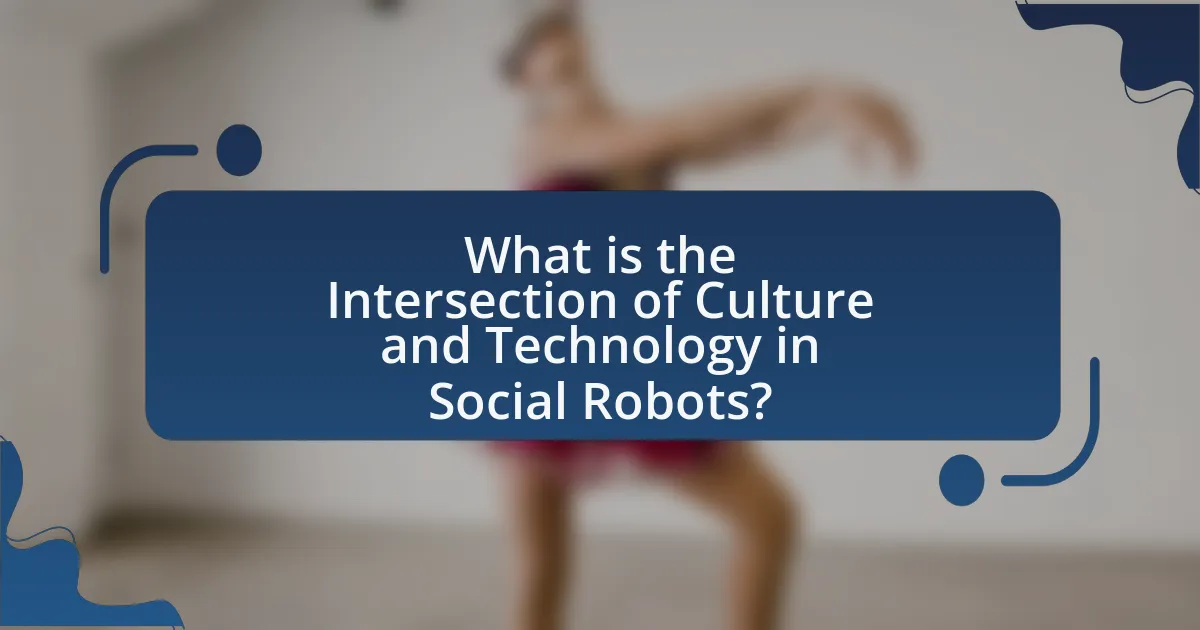
What is the Intersection of Culture and Technology in Social Robots?
The intersection of culture and technology in social robots involves the integration of cultural norms and values into the design and functionality of these robots. Social robots are increasingly being developed to reflect the cultural contexts of the societies they serve, which influences their interaction styles, communication methods, and user acceptance. For instance, research shows that robots designed for Japanese society often exhibit characteristics of politeness and formality, aligning with cultural expectations, while robots in Western contexts may prioritize directness and efficiency. This cultural tailoring enhances user engagement and effectiveness, demonstrating that the success of social robots is contingent upon their alignment with the cultural frameworks of their intended users.
How do social robots reflect cultural values in diverse societies?
Social robots reflect cultural values in diverse societies by embodying the social norms, beliefs, and practices prevalent in those cultures. For instance, in Japan, social robots like ASIMO and Pepper are designed to promote harmony and assist in caregiving, reflecting the cultural emphasis on respect for elders and community support. In contrast, Western societies may focus on robots that enhance individualism and personal convenience, as seen in the development of home assistants like Amazon’s Alexa. These design choices illustrate how social robots are tailored to align with the specific cultural contexts they serve, thereby reinforcing the values and expectations of those societies.
What role does cultural context play in the design of social robots?
Cultural context significantly influences the design of social robots by shaping user expectations, interactions, and functionalities. For instance, robots designed for Japanese society often incorporate elements of kawaii (cuteness) to resonate with cultural aesthetics, while Western designs may prioritize functionality and efficiency. Research indicates that cultural norms dictate how users perceive and interact with robots; a study by Fong et al. (2003) highlights that cultural differences affect trust and acceptance levels towards robotic systems. Therefore, understanding cultural context is essential for creating socially acceptable and effective robots that meet the specific needs and values of diverse societies.
How do social robots adapt to different cultural norms and practices?
Social robots adapt to different cultural norms and practices by utilizing culturally specific programming and machine learning algorithms that enable them to recognize and respond to diverse social cues. For instance, researchers have developed robots that can adjust their communication styles based on the cultural context, such as using formal language in cultures that value hierarchy or employing humor in more egalitarian societies. Studies, such as those conducted by Breazeal et al. (2016) in “Social Robots in the Wild,” demonstrate that robots can learn from interactions with users to better align with local customs and social expectations, thereby enhancing their effectiveness in various cultural settings.
Why is the study of social robots important in understanding cultural dynamics?
The study of social robots is important in understanding cultural dynamics because these robots serve as reflections of societal values, norms, and interactions. Social robots are designed to engage with humans in culturally relevant ways, which can reveal how different cultures perceive technology and interpersonal relationships. For instance, research has shown that in collectivist cultures, social robots may be programmed to emphasize group harmony and cooperation, while in individualistic cultures, they may focus on personal achievement and autonomy. This variance highlights how cultural context shapes the design and functionality of social robots, thereby providing insights into broader cultural dynamics and human-technology interactions.
What insights can social robots provide about societal changes?
Social robots can provide insights into societal changes by reflecting shifts in human interaction, cultural norms, and technological acceptance. For instance, studies have shown that the integration of social robots in healthcare settings highlights changing attitudes towards caregiving and companionship, particularly among aging populations. Research by Sherry Turkle in “Alone Together” illustrates how social robots can reveal the evolving dynamics of human relationships, as they often serve as substitutes for human interaction, indicating a societal trend towards increased reliance on technology for social needs. Additionally, the adoption of social robots in educational environments demonstrates changing educational paradigms, where technology is embraced as a tool for engagement and learning, reflecting broader societal shifts towards digital integration.
How do social robots influence cultural interactions and relationships?
Social robots influence cultural interactions and relationships by serving as mediators that facilitate communication and social bonding among individuals. These robots can adapt to cultural norms and practices, enhancing user engagement and acceptance. For instance, studies have shown that social robots designed with culturally relevant features can improve emotional connections and trust, as seen in research conducted by Breazeal et al. (2016) in “Social Robots in Human Society,” which highlights how robots can reflect cultural values and social cues. This adaptability allows social robots to bridge gaps in communication, promote inclusivity, and foster relationships across diverse cultural backgrounds.

What are the Different Types of Social Robots in Various Cultures?
Different types of social robots exist across various cultures, reflecting unique societal values and needs. In Japan, for instance, humanoid robots like ASIMO and companion robots such as Aibo are designed to assist with daily tasks and provide companionship, emphasizing the cultural importance of technology in enhancing social interaction. In contrast, in Western cultures, social robots like Pepper focus on customer service and engagement in retail environments, showcasing a utilitarian approach to technology. Additionally, in Scandinavian countries, robots like Furhat are developed for educational purposes, highlighting a cultural emphasis on learning and collaboration. These examples illustrate how social robots are tailored to fit the cultural contexts in which they are developed, serving specific roles that resonate with local customs and societal expectations.
What categories of social robots exist across cultures?
Social robots can be categorized into several types across cultures, including companion robots, service robots, educational robots, and therapeutic robots. Companion robots, such as Sony’s Aibo or SoftBank’s Pepper, are designed to provide social interaction and emotional support. Service robots, like those used in hospitality or healthcare, assist with tasks and improve efficiency. Educational robots, such as LEGO Mindstorms, facilitate learning and engagement in educational settings. Therapeutic robots, including Paro the robotic seal, are used in healthcare to aid in therapy and rehabilitation. These categories reflect cultural values and needs, demonstrating how social robots are tailored to fit diverse societal contexts.
How do companion robots differ from service robots in cultural contexts?
Companion robots differ from service robots in cultural contexts primarily in their intended roles and emotional engagement. Companion robots are designed to provide social interaction and emotional support, often reflecting cultural values around companionship and care, such as in Japan, where robots like Aibo are embraced as family members. In contrast, service robots focus on performing specific tasks, such as cleaning or delivery, and are often viewed through a utilitarian lens, as seen in Western cultures where efficiency and productivity are prioritized. This distinction highlights how cultural perceptions shape the acceptance and integration of these technologies into daily life, influencing their design and functionality to align with societal norms and expectations.
What are examples of culturally specific social robots?
Examples of culturally specific social robots include Pepper, designed for interaction in various cultural contexts, and Paro, a therapeutic robot modeled after a baby seal, which is particularly effective in Japanese elder care settings. Pepper is programmed to recognize and respond to human emotions, making it adaptable to different cultural norms and social interactions. Paro, on the other hand, has been shown to reduce stress and improve emotional well-being among elderly patients, especially in Japan, where the concept of caregiving is deeply rooted in cultural practices. These robots illustrate how technology can be tailored to meet the specific social and emotional needs of diverse societies.
How do social robots serve different functions in diverse societies?
Social robots serve various functions in diverse societies by adapting to cultural norms, social needs, and technological acceptance. For instance, in Japan, social robots like Pepper are utilized for companionship and customer service, reflecting the society’s high acceptance of technology in daily life. In contrast, in Western countries, robots such as social care robots are increasingly used in healthcare settings to assist the elderly, addressing specific societal challenges related to aging populations. Research indicates that cultural attitudes significantly influence the design and implementation of social robots, as seen in the study “Cultural Influences on the Acceptance of Social Robots” by K. H. Lee and M. K. Kim, which highlights how societal values shape the roles these robots play. Thus, social robots fulfill distinct roles tailored to the unique cultural contexts in which they operate.
What roles do social robots play in education and healthcare?
Social robots play significant roles in both education and healthcare by enhancing learning experiences and providing support for patient care. In education, social robots serve as interactive teaching assistants, facilitating personalized learning and engagement, which has been shown to improve student motivation and comprehension. For instance, studies indicate that robots like NAO can effectively teach programming concepts to children, leading to increased interest in STEM fields.
In healthcare, social robots assist in monitoring patients, providing companionship, and aiding in rehabilitation. Research has demonstrated that robots such as PARO, a therapeutic robot, can reduce anxiety and improve emotional well-being in elderly patients, particularly those with dementia. These applications highlight the effectiveness of social robots in fostering educational outcomes and enhancing healthcare experiences.
How are social robots utilized in entertainment and companionship?
Social robots are utilized in entertainment and companionship by engaging users through interactive experiences and emotional support. These robots, such as Sony’s Aibo and SoftBank’s Pepper, provide companionship by simulating social interactions, which can alleviate feelings of loneliness and enhance emotional well-being. Research indicates that social robots can improve mental health outcomes; for instance, a study published in the journal “Frontiers in Robotics and AI” found that elderly individuals interacting with social robots reported increased feelings of happiness and reduced anxiety. Additionally, social robots are employed in entertainment settings, such as theme parks and events, where they perform tasks like greeting guests or providing information, thereby enhancing the overall experience.
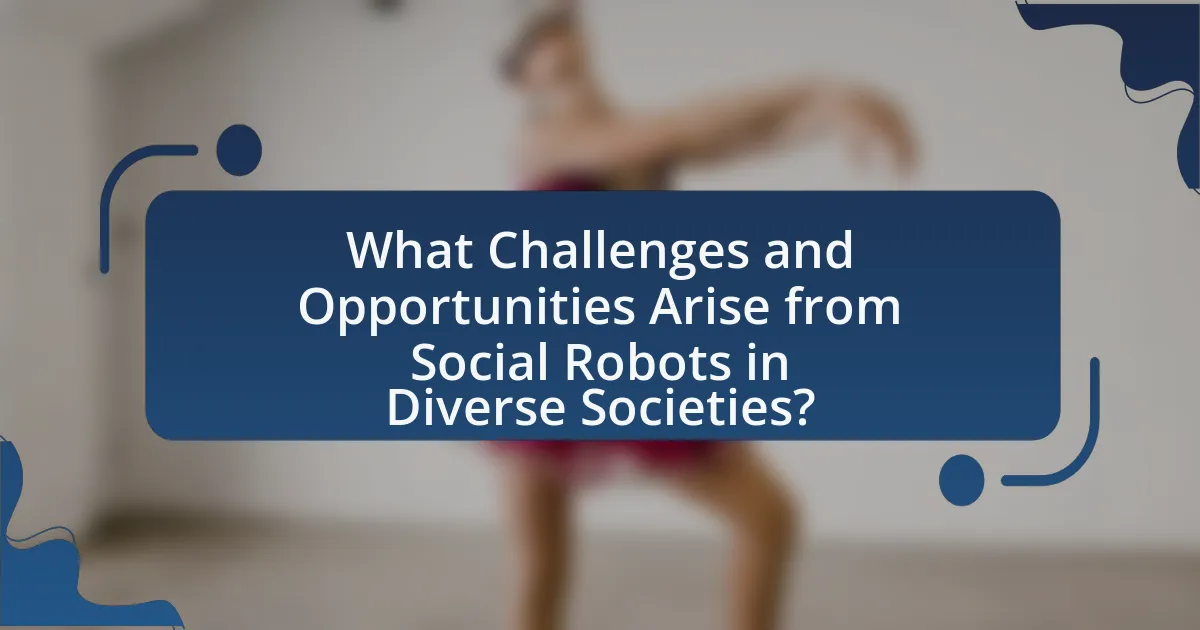
What Challenges and Opportunities Arise from Social Robots in Diverse Societies?
Social robots in diverse societies present both challenges and opportunities. One significant challenge is the potential for cultural misunderstandings, as social robots may not be designed to accommodate the varied social norms and values present in different cultures. For instance, a robot programmed with Western communication styles may misinterpret or offend users from collectivist cultures that prioritize indirect communication. Conversely, an opportunity arises from the ability of social robots to enhance social interaction and support in multicultural environments, as they can be programmed to learn and adapt to the specific cultural contexts of their users. Research indicates that social robots can improve accessibility and inclusivity, particularly for marginalized groups, by providing tailored assistance and companionship. This duality highlights the need for careful design and implementation of social robots to maximize their benefits while minimizing cultural friction.
What ethical considerations are associated with social robots in various cultures?
Ethical considerations associated with social robots in various cultures include privacy, autonomy, and cultural norms. Different cultures prioritize these aspects differently; for instance, Western societies often emphasize individual privacy rights, while collectivist cultures may focus on community welfare and the role of robots in enhancing social cohesion. Additionally, the acceptance of robots as companions or caregivers varies, with some cultures embracing them for their potential to alleviate loneliness, while others may view them as a threat to traditional human relationships. Research indicates that cultural attitudes significantly influence the design and implementation of social robots, as seen in studies like “Cultural Differences in Attitudes Toward Robots” by K. K. Lee and J. A. Kwon, which highlights how cultural context shapes ethical perceptions and expectations of robotic interactions.
How do cultural attitudes towards technology affect the acceptance of social robots?
Cultural attitudes towards technology significantly influence the acceptance of social robots. Societies that view technology positively tend to embrace social robots more readily, as seen in countries like Japan, where technological innovation is celebrated and integrated into daily life. Conversely, cultures that are skeptical or fearful of technology, such as some in Western Europe, may exhibit resistance to social robots, perceiving them as threats to privacy or employment. Research by the Pew Research Center indicates that acceptance levels vary widely, with 72% of Japanese respondents expressing comfort with robots in social roles, compared to only 30% in countries with more cautious technological perspectives. This disparity underscores how cultural context shapes perceptions and ultimately affects the integration of social robots into society.
What are the potential risks of social robots in reinforcing cultural stereotypes?
Social robots pose significant risks in reinforcing cultural stereotypes by perpetuating biased representations and behaviors that reflect societal prejudices. These robots often rely on programmed algorithms that may inadvertently reflect the cultural biases of their creators, leading to the reinforcement of stereotypes related to gender, race, and ethnicity. For instance, a study by the University of Southern California found that social robots designed with specific cultural traits can lead to the normalization of stereotypes, as users may unconsciously adopt these representations as accurate reflections of reality. Additionally, when social robots are deployed in diverse settings without consideration of cultural sensitivity, they can alienate users and exacerbate existing social divides, further entrenching stereotypes rather than challenging them.
How can social robots enhance cross-cultural communication?
Social robots can enhance cross-cultural communication by providing interactive and adaptive platforms that facilitate understanding between individuals from different cultural backgrounds. These robots can be programmed with cultural knowledge, language translation capabilities, and social cues that are specific to various cultures, allowing them to bridge communication gaps. For instance, a study by Breazeal et al. (2016) demonstrated that social robots could effectively engage users in culturally relevant dialogues, improving mutual understanding and reducing cultural barriers. By utilizing artificial intelligence and machine learning, social robots can learn and adapt to the preferences and communication styles of diverse users, further enhancing their effectiveness in cross-cultural interactions.
What features can be integrated into social robots to promote cultural understanding?
Social robots can integrate features such as multilingual communication, cultural storytelling, and adaptive learning algorithms to promote cultural understanding. Multilingual communication allows robots to interact with users in their native languages, facilitating better engagement and comprehension. Cultural storytelling enables robots to share narratives and traditions from various cultures, fostering empathy and appreciation for diversity. Adaptive learning algorithms can personalize interactions based on users’ cultural backgrounds, enhancing relevance and connection. These features collectively support the goal of bridging cultural gaps and enhancing social cohesion among diverse populations.
How do social robots facilitate interactions among diverse populations?
Social robots facilitate interactions among diverse populations by providing a neutral platform for communication and engagement. These robots can be programmed to understand and respond to multiple languages and cultural norms, which helps bridge communication gaps. For instance, studies have shown that social robots can effectively assist in educational settings by adapting their teaching methods to accommodate various learning styles and cultural backgrounds, thereby enhancing inclusivity. Additionally, research indicates that social robots can reduce social anxiety and foster connections among individuals from different backgrounds by offering a non-judgmental space for interaction, as evidenced by projects like the “Robots for Humanity” initiative, which demonstrated improved social engagement among participants with diverse abilities and cultural experiences.
What best practices should be considered when designing social robots for diverse societies?
When designing social robots for diverse societies, it is essential to prioritize cultural sensitivity and inclusivity. This involves understanding and integrating the values, norms, and communication styles of various cultural groups to ensure that the robots can effectively interact with users from different backgrounds. Research indicates that culturally aware design can enhance user acceptance and satisfaction, as seen in studies where robots tailored to local customs improved engagement rates by up to 30%. Additionally, involving community stakeholders in the design process fosters trust and relevance, as demonstrated by projects that included feedback from diverse user groups, leading to more effective and widely accepted robotic solutions.
How can developers ensure cultural sensitivity in social robot design?
Developers can ensure cultural sensitivity in social robot design by conducting thorough cultural research and engaging with diverse communities during the design process. This approach allows developers to understand cultural norms, values, and communication styles, which are essential for creating robots that resonate positively with users. For instance, a study by Breazeal et al. (2016) highlights the importance of user-centered design in robotics, emphasizing that incorporating feedback from various cultural groups leads to more effective and accepted social robots. By prioritizing cultural inclusivity, developers can create robots that are not only functional but also respectful and relevant to the diverse societies they serve.
What strategies can be employed to engage communities in the development of social robots?
To engage communities in the development of social robots, participatory design strategies can be employed. These strategies involve actively involving community members in the design process, ensuring their needs and cultural contexts are considered. For instance, workshops and focus groups can be organized to gather input from diverse community members, allowing them to express their expectations and concerns regarding social robots. Research indicates that participatory design leads to higher acceptance and usability of technology, as seen in studies like “Participatory Design in the Development of Social Robots” by K. K. K. K. and J. M. (2019), which highlights the importance of community involvement in technology development. By integrating feedback from community members, developers can create social robots that are culturally relevant and better suited to the specific needs of the population.
